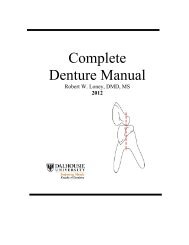RPD Manual 11 - Removable Prosthodontics - Dalhousie University
RPD Manual 11 - Removable Prosthodontics - Dalhousie University
RPD Manual 11 - Removable Prosthodontics - Dalhousie University
Create successful ePaper yourself
Turn your PDF publications into a flip-book with our unique Google optimized e-Paper software.
Denture Bases - 62<br />
of the natural dentition, particularly once the surface glaze has been broken. Acrylic teeth are<br />
easier to arrange, modify and adjust.<br />
Tooth Form<br />
The selected tooth form should be selected to harmonize with the opposing teeth. Where the<br />
replacement teeth oppose natural dentition with minimal wear, a 30° or 33° tooth form may be<br />
indicated. Where the opposing dentition exhibits advanced occlusal wear, a form with more<br />
shallow or no cuspal inclinations might be indicated. In almost all instances where the teeth will<br />
oppose a natural dentition, adjustment of the occlusal surfaces will be necessary to provide<br />
acceptable occlusal contacts.<br />
Denture teeth should be selected to harmonize with the shade, shape, length and width of the<br />
remaining dentition. Appearance will be most compromised if there is a vast difference in tooth<br />
length between the replacement tooth and adjacent natural teeth.<br />
In order to improve esthetics, teeth adjacent to the abutment teeth may have to be modified to<br />
ensure the proximal plates and other framework components do not interfere with proper<br />
positioning of the denture teeth. Replacement teeth may be modified so they can veneer over<br />
proximal plates and other framework elements to provide the best possible appearance.<br />
The denture tooth is adjusted to<br />
provide room for the proximal<br />
plate, while allowing placement of<br />
the tooth close to the natural tooth<br />
for best appearance. Note on the<br />
facial surface that the denture<br />
tooth slightly overlaps the<br />
proximal plate to hide this portion<br />
of the framework.<br />
Occlusal Scheme<br />
The occlusal scheme selected for a partial denture may vary from a fully balanced occlusal<br />
scheme when opposing a complete denture, to an anterior disclusion arrangement when a tooth<br />
borne partial opposes a natural dentition with all remaining natural anterior teeth. If the partial<br />
denture can be made with a scheme that does not require balance to ensure its stability, then a<br />
nonbalanced scheme should be chosen. As more of the occlusal table is involved in the<br />
prosthetic replacement teeth, the more a balanced occlusal scheme may be of benefit.















